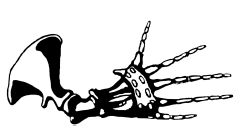
Alfredo Herrera is a Real Estate agent at Tropicasa Realty in Puerto Vallarta, Mexico, and one of his interests is photographing humpback whales in Banderas Bay every winter. (Photo © Alfredo Herrera)
Alfredo Herrera – Tropicasa Realty
Puerto Vallarta, Mexico – One of the amazing things about living in Puerto Vallarta is that every winter, humpback whales come to Banderas Bay to breed, give birth, and nurse their calves until they are ready to migrate to their feeding grounds in the north.
Equally amazing is the fact that as marine mammals they evolved from a four-legged land mammalcalled Pakicetus that lived approximately 55 million years ago in what is now Pakistan (the name means whale from Pakistan.) The sediments where the first fossils were found were part of the ancient Tethys Sea where Pakicetus, no one really knows why, is believed to have taken to the water to feed, maybe because it was difficult for it to find food on land or because there was a lot of food in the water to be taken advantage of. Whatever the reason was as time went by, it evolved, adapting itself to the aquatic environment.
But as mammals, whales have all the characteristics that all mammals have: to name a few they have mammary glands and nurse their babies with milk, they give birth to live young (unlike reptiles that are born from an egg, (although there are 2 species of mammals that do lay eggs…), they have lungs and breathe air, they maintain a constant body temperature, and they all have hair… at least at a certain stage in their development.
 |
|
In Rorquals and Gray whales there are only four digits instead of five; the thumb bones are not present.
|
Marine mammals have different levels of adaptation to the aquatic environment, of which Cetaceans (whales, dolphins and porpoises) are the most adapted, living their entire lives at sea.
However, they still have physical remnants of their terrestrial origins. For example, the pectoral flippers of whales and dolphins have all the skeletal elements of terrestrial mammals – but they are modified into paddle-shaped appendages.
Also, humpbacks have knobby protuberance on their rostrums and under their jaw where they have whisker-like hairs connected to a dense network of nerves. The exact function of these vibrissae is not clear but it is believed it may help them to navigate or during feeding.
Humpbacks are amazing creatures and we are fortunate that they have chosen our bay to reproduce, giving us the opportunity to see their behavior during one of the most exciting cycles of their lives, their breeding cycle.
Alfredo Herrera is a Real Estate agent at Tropicasa Realty, and one of his interests is photographing humpback whales in Banderas Bay. If you would like to get in touch with Alfredo, please visit alfredoherrera.point2agent.com, or email him at alfredoh@tropicasa.com

